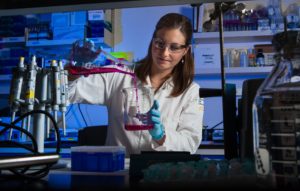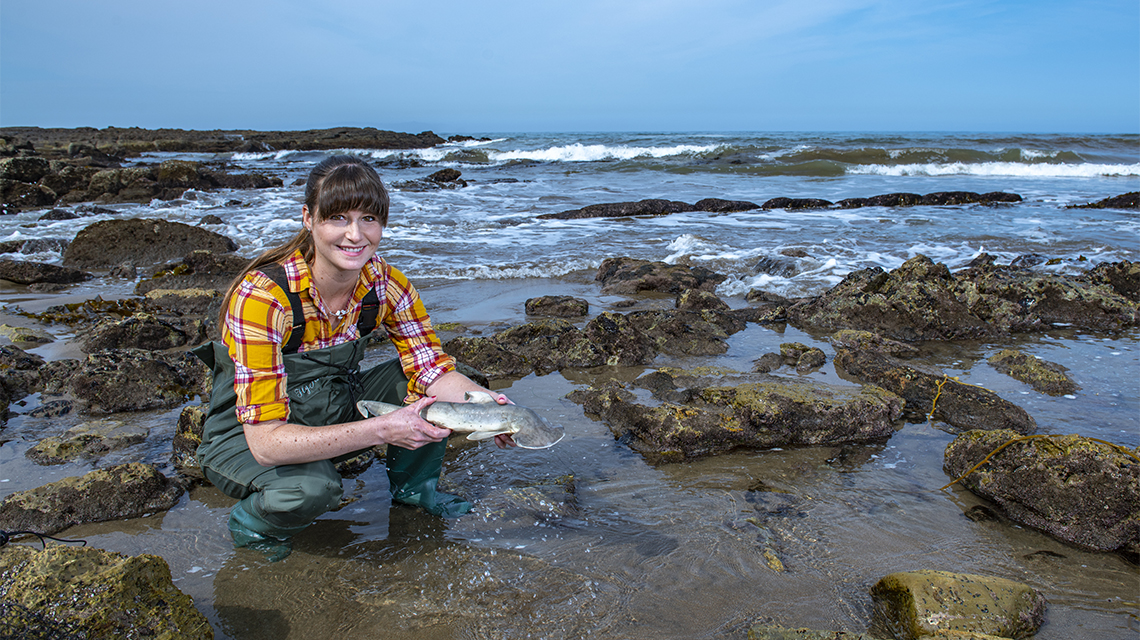Sitting offshore in a small boat in the Florida Keys, CSUDH Assistant Professor of Biology Samantha Leigh tosses chum into the shallow water. The pungent slurry of chopped-up fish parts is the best way to attract her targets, so she keeps a close eye on the long gillnets she has laid perpendicular to the shoreline. When Leigh spots a disturbance in a net, she jumps in and makes her way to a snared bonnethead shark, which she untangles and places in a live tank inside the boat.
After netting a couple more, Leigh takes her catches to a lab facility, where the bonnetheads are released into tanks with ocean water flow-through systems. These allow the sharks to acclimate to their new surroundings and prepare them for a microbiome study.
Leigh, who joined the faculty at CSUDH in 2020, is an animal physiologist interested in how organisms acquire energy based on their specified feeding mechanisms and digestive strategies. In 2018, while a doctoral student in the Department of Ecology and Evolutionary Biology at UC Irvine’s (UCI) School of Biological Sciences, she was among a group of scientists who discovered bonnetheads were omnivorous.
Her discovery of the only known omnivorous shark species has been turning heads throughout the scientific community. Leigh’s groundbreaking work was featured among National Geographic’s “Most Fascinating Shark Discoveries of the Past Decade,” and has also received coverage in publications such as the New York Times and the Guardian.
Leigh is continuing her research on bonnetheads at CSUDH, and early this year, she was lead author on “Gut Microbial Diversity and Digestive Function of an Omnivorous Shark,” which was published in the journal Marine Biology.
Bonnetheads and Microbial Research
The bonnethead is a member of the hammerhead shark family. Only one meter in length on average, it is found in the Gulf of Mexico and throughout the Florida Keys, as well as off the Baja Peninsula. Unlike its carnivorous cousins, the bonnethead includes seagrass as part of its protein-rich diet of prey items of mostly crustaceans, plus some squid and small fish, making it uniquely positioned to help advance further understanding of microbiomes in sharks.
A microbiome is the collection of all microbes, such as bacteria, fungi, viruses, and their genes, that naturally live on and inside animals–from sharks to humans. They contribute to organisms’ health and wellness in many ways: protecting against pathogens, helping the immune system, and enabling animals to digest food.
As scientists learns more about intestinal microbiomes, “the more we are realizing that they play an important role in an organism’s overall health,” says Leigh. “Microbes can affect when and what diseases an organism may acquire, whether they will become obese or not, and many other physiological functions.”
But while the microbiomes in the intestinal tract of many land animals have been well researched, knowledge about microbe-host interactions in marine systems is limited, particularly among those higher on the food chain, such as sharks and other carnivores. Leigh says she can count the number of such studies on sharks on one hand.
“Most researchers are drawn to herbivores and omnivores because they usually have more interesting microbiomes,” says Leigh, explaining that as a result of eating plant matter, which is difficult or impossible for the naturally created enzymes in their bodies to digest, the microbiomes in their systems are much more robust. “But now we know that at least the bonnethead shark is acting more like an omnivore by eating seagrass. My hope is that this research sparks some interest in looking at other shark species more closely, even if they are strictly carnivorous.”

Leigh says that researching shark microbes is important because, “We obtain microbes from many sources, but one source is the food that we eat. Those of us who eat seafood, eat many of the same things that sharks do!”
During her bonnethead research, Leigh used digestive enzymes, tissue samples, DNA sequencing, and measured microbial fermentation to examine the processes by which the bonnethead may digest and assimilate plants.
All organisms that consume plant material need fermentation for digestion, says Leigh. The sharks she studied received a diet that consisted of 90 percent Florida Bay seagrass and 10 percent squid. This resulted in the increased fermentation of carbohydrate-based sources. Leigh also compared levels of fermentation produced by the microbes in their test sharks’ guts to bonnetheads in the wild.
“The wild sharks were pretty on par with animals that ferment protein as opposed to fiber, while the ones we fed in the lab that were getting mostly seagrass definitely ramped up the fermentation of carbohydrate-based sources,” Leigh shares. “So, it does seem to depend on what their main food source is and how much the microbes are going to ferment carbs versus proteins.”
The microbes Leigh identified are known to use enzymes responsible for the breakdown of chitin found in crustaceans, and components of cellulose that is found in seagrass. Both are a significant part of bonnethead shark’s diet.
While Leigh’s work resulted in some significant discoveries, the mechanisms by which an omnivore shark like the bonnethead digests seagrass, including microbial digestion, are still unknown.
“We’re still trying to figure out how this particular shark microbiome compares to the stereotypical shark microbiome,” Leigh says. “Our hope is that our work might help encourage others to do more shark research. That’s something that I’m hoping to do as well to help build a database of shark microbiomes that can be used by others to compare across species.”
Leigh’s work is also important from a conservation standpoint. Because bonnetheads are a highly abundant species that lives in fragile seagrass meadow habitats, their eating habits can affect the ecosystem. But Leigh says that many seagrass management strategies are not accounting for a large population of sharks feeding on the grass.
“As omnivores, the sharks may be acting as nutrient distributors throughout these seagrass meadows,” says Leigh. “Understanding the sharks’ role in seagrass ecosystem dynamics is important because they provide nursery habitats for thousands of other species, produce oxygen we need to breath, and much more. It’s important that we conserve them to the best of our ability, and understanding the bonnetheads’ impact will help in these vital efforts.”










